最新语文版中职英语基础模块 上册unit 3《campus life》教案.doc
- 格式:doc
- 大小:54.00 KB
- 文档页数:7

职教中心基础模块 unit3 Campus Life第一卷选择题Ⅰ. Choose the best answer to complete the sentences. (20%)( ) 1. The young man shows concern______ his girlfriend.A. withB. toC. on D about( ) 2. My father can__________ several foreign language.A.speakB. sayC. talkD. tell( ) 3. Today , I’ll ____________with you.A.speakB. sayC. talkD. tell( ) 4. I bought a new car three days_____.A. agoB.beforeC.afterD. later( ) 5.The monkey had eaten all nut_______the cat found him.A. agoB.beforeC.afterD. later( ) 6.I ______there at 3:00.A. gotB. arrived atC.arrived inD. reached to( ) 7.My mother will _________Beijing in 3 days.A. getB. arrive atC. arriveD.reach( ) 8. It’s kind______________me.A. for him to helpB. of him to helpC. for him helpingD. of him helping( ) 9. ___________first, I only know his name.A. ForB. OnC. AtD. In( ) 10. The young man always shows __________his brand coats.A. ofB. upC.outD.off( )11. In the 1980s, some big factories shows________.A.onB.offC.outD. up( )12. The young lady always helps the old ______their housework.A. forB.inC.onD. with( )13. I think everything___________.A.goes wellB. go wellC.to speakD. spoke ( )14.70 as he is , he always practises_______English every day .A. speakB. speakingC. areD. do( )15. The young man ate four_________for breakfast.A.eggB. eggesC. eggsD. eggies( )16. The two ______lost their husbands because of the small things.A. boyB. boyesC. boysD. boies( )17. Today, my father bought two_______for lunch.A.fishB. fishesC.fishsD. fishies( )18. Two________killed three ________in that battleA.English, JapaneseB. English, Japanese menC. English men, JapaneseD. English men, Japanese men( )19. Yesterday evening, my brother bought three _________for himself. A. tooth brush B. teeth brush C. tooth brushes D. teeth brushes( )20. The room is _______bedroom. Kate is a friend of_________.A. Kate and Betty’s , Ja ck’s sister’sB. Kate’s and Betty’s, Jack’s sister’sC. Kate’s and Betty, Jack’s sisterD. Kate’s and Betty’s, Jack’s sisterⅡ. Choose the best answer for each blank to complete the passage.Tom grows the nicest vegetables and fruits and the most beautiful flowers in the village. Plants grow in Tom’s garden all through the __21__ and they are much__22__.Tom cuts some flowers for his sitting room table, eats some fruits and vegetables, but he __23__ most of them in the market. His vegetables, fruit and flowers are so__24__ and beautiful that they sold much more __25__ in the market than those of other villagers.How does Tom grow these beautiful things? He is so __26__ that he just sits under his orange tree with his radio.He __27__ the music all day.That is quite true. Tom __28__ things in spring, summer, autumn and winter. After that he sits with his radio. And everything __29__. It is the music that does the work. Tom knows more clearly that music makes the biggest vegetables and the mostbeautiful flowers. Plants love __30__ as much as people.21. A. week B. month C. season D. year22. A. better B. worse C. less D. later23. A. buys B. sells C. borrows D. lends24. A. dear B. bad C. big D. small25. A. politely B. quickly C. slowly D. carefully26. A. angry B. busy C. tired D. lazy27. A. listens to B. hears C. watches D. speaks28. A. fills B. plants C. throws D. makes29. A. does B. moves C. grows D. plays30.A. work B. rain C. stories D. musicⅢ. Read the passages and choose the best answer for each blank. (30%)(A)Two farmers were on their way home one evening after a hard day's work. Both were tired. They happened to look up at the sky and saw a black cloud overhead."Ah!" said one farmer, "tomorrow we shall have rain and the rice will grow well." The second answered, "Nonsense (胡说), the rain will only kill the crops (庄稼)."So they began to quarrel (争吵). Just then a third farmer came along and asked them why they were quarreling. Both farmers explained about the black cloud."What cloud?" asked the third farmer. They all looked at the sky. The cloud was no longer there.Choose the right answer31. The two farmers were _____.A. going homeB. going to the fieldC. going to workD. going to see their friend32. The two farmers _____ on that day.A. had a holidayB. didn't workC. worked hardD. wanted to quarrel with each other 33. When there are black block clouds in the sky, _____.A. it will rain soonB. it will be fineC. it will get hotD. the sun is shining brightly34. The two farmers fought in words because _____.A. they were hungryB. it rainedC. one said the rain would do good to the crops and the other didn't think soD. they both hoped for rain35. The third farmer came with and said to the other two. He _____.A. wanted to make friends with themB. joined them in the quarrelC. wanted to know why they were quarrelingD. had nothings to do(B)One day Bob took two of his friends in-to the mountains. They put up their tents (帐篷) and then rode off to a forest to see how the trees were growing.In the afternoon when they were about ten kilometers from their camp(营地), itstart-ed to snow. More and more snow fell. Soon Bob could hardly see his hands before his face. He could not find the road. Bob knew there were two roads. One road went to the camp, and the other went to his house. But all was white snow. Everything was the same. How could he take his friends back to the camp?Bob had an idea. The horses! Let the horses take them back! But what wouldhap-pen if the horses took the road to his house? That would be a trip of thirty-five kilometers in such cold weather!It was getting late. They rode on and on. At last the horses stopped. Where were they? None of them could tell. John looked around. What was that under the tree? It was one of their tents!36. John and his two friends went to the forest to ____.A. build their campB. find their way homeC. enjoy the mountains in the snowD. watch the trees in the forest37. They could not find their way back because ____.A. there was only one road to their campB. they couldn't decide which of the two roads led to their tentsC. there were no roads in the mountains at allD. everything was covered by the white snow38. It is clear that they wanted the horses to take them to ____.A. John's houseB. the campC. the forestD. the mountains39. The horses stopped because____.A. it was getting lateB. they were tired after running for a long wayC. they knew that they had got to the campD. they had seen John's house40. The story happened ____.A. on a cold winter dayB. on a dark snowy eveningC. in a cold camp far from villagesD. at night when nothing could be seen (C)Australia has a lot of lovely animals . You cannot find them anywhere else in the world . The most famous ones are kangaroos and koalas.The kangaroo is the symbol of Australia.They have large eyes and eats . They don't walk, they jump.They use their strong back legs . They can jump at 74 kilometers per hour . They can go over nine meters in one jump . Kangaroo mothers have pouches to carry their babies. The babies stay inside to get milk and keep warm.Kangaroos are everywhere in Australia . They are on TV, in books and in the shops . But do you know that millions of kangaroos are killed every year?There are too many of them . There are about 20 to 25 million kangaroos in Australia. That's more than the number of people in the counery. Some kangaroos go humgry because there is not enough food to eat . They break into farms for food Farmers are very angry with them.The koala is another famous Australian animal . They look like bears , and have small eyes and big noses. They eat leaves from gum trees.Koalas have a.They use it to mark their home----"This is my place,you can't come in!" like kangaroos,a koala baby lives in its mother's pouch,too.()1.If we want to see kangaroos and koalas in natural forests. we can goto________.A.ChinaB.FranceC.Australia()2.What does a kangaroo look like?A.It looks like a bear.B.It has big eyes and ears.C.It has small eyes and big noses.()3.The work "pouch" means__________.A.育儿袋B.肌肉C.尾巴()4.Which is NOT TRUE?____________A.The kangaroos can go over nine meters in one jump.B.Koalas like eating leaves from gum trees.C.Koalas use their voices to mark their homes()5.What's the best title of this passage?________.A.Kangaroos and koalasB.Beautiful AustraliaC.How to protect kangaroos and koalas.第二卷非选择题姓名___________班级________Ⅰ. Translate the following phrases. (10%)46. the skill training center 47. on weekends48. have a good time 49. Chinese cooking50. text message 51 .在课堂上52. 进展53. 上课54. 在下午55. 去观光Ⅱ. Translate the following sentences. (20%)56. How are you getting along?57. Please tell me your telephone number and e-mail address.58. Everything is going well.59.When I got to this school, everything was strange to me.60. Haste(匆忙,急速) does not bring success.61.She________________________ the house. 她告诉我去打扫屋子。
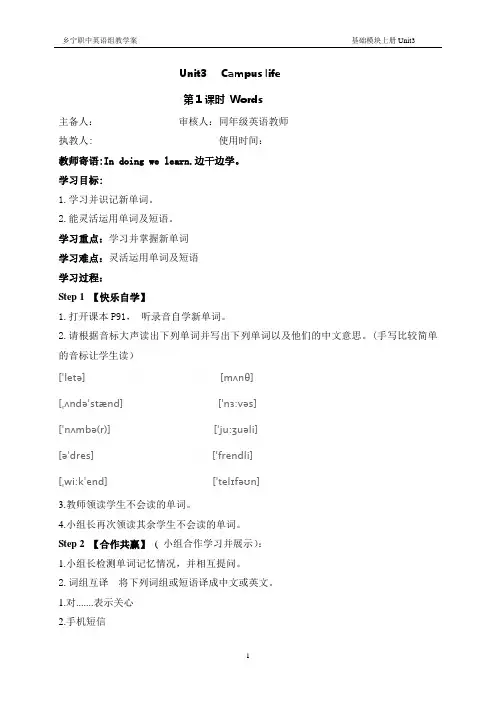
Unit3 Campus life第1课时Words主备人:审核人:同年级英语教师执教人: 使用时间:教师寄语:In doing we learn.边干边学。
学习目标:1.学习并识记新单词。
2.能灵活运用单词及短语。
学习重点:学习并掌握新单词学习难点:灵活运用单词及短语学习过程:Step 1 【快乐自学】1.打开课本P91,听录音自学新单词。
2.请根据音标大声读出下列单词并写出下列单词以及他们的中文意思。
(手写比较简单的音标让学生读)[ˈletə] ______________[mʌnθ]_______ _______[ˌʌndəˈstænd]_______ _______[ˈnɜ:vəs]_______ _______[ˈnʌmbə(r)] _______ _______[ˈju:ʒuəli]_______ _______[əˈdres] _______ _______[ˈfrendli]_______ _______[ˌwi:kˈend]_______ _______[ˈtelɪfəʊn]_______ _______3.教师领读学生不会读的单词。
4.小组长再次领读其余学生不会读的单词。
Step 2 【合作共赢】( 小组合作学习并展示):1.小组长检测单词记忆情况,并相互提问。
2.词组互译将下列词组或短语译成中文或英文。
1.对.......表示关心_____________________2.手机短信______________________3. 在......的帮助下_________________________4.进展顺利________________________5.去观光___________________6. on weekends _________________________7. in class_______________________8. at first ___________________9.get to ________________10.have a good time _________________________Step 3 【当堂检测】1._____________(三个月以前),Linda could not speak Chinese.1.When i first got here, _____________(一切对于我都很陌生).2.He often _____________(练习英文)on weekends.3.My parents and i _____________(玩的愉快)when we visited Qingdao last summer.4.How are you _____________(相处)with your new classmates now?Step 4 【大显身手】将下列句子翻译成英语1.你们想要两本水吗?_________________________2.请看图片上的三只土豆。
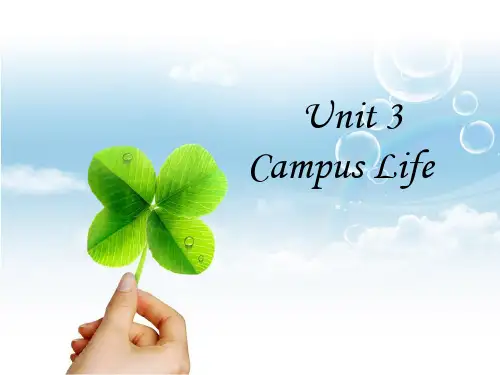
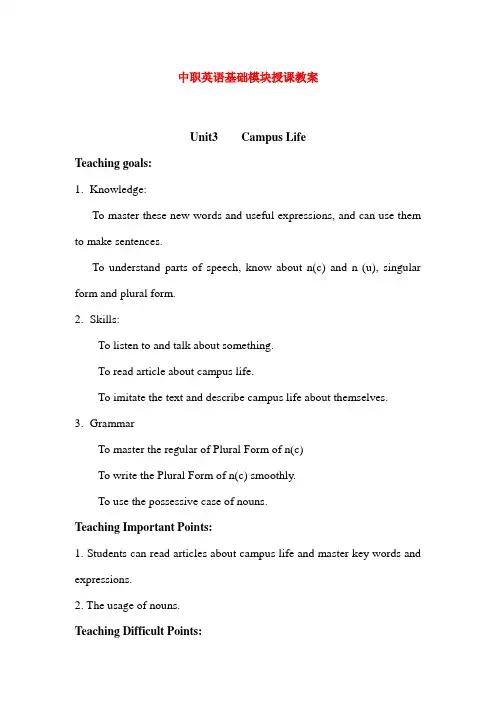
中职英语基础模块授课教案Unit3 Campus LifeTeaching goals:1.Knowledge:To master these new words and useful expressions, and can use them to make sentences.To understand parts of speech, know about n(c) and n (u), singular form and plural form.2.Skills:To listen to and talk about something.To read article about campus life.To imitate the text and describe campus life about themselves.3.GrammarTo master the regular of Plural Form of n(c)To write the Plural Form of n(c) smoothly.To use the possessive case of nouns.Teaching Important Points:1. Students can read articles about campus life and master key words and expressions.2. The usage of nouns.Teaching Difficult Points:1.How to train the students’ reading ability.2.How to train the students’ ability to use nouns.Teaching ways:Combine speaking with reciting, teach by a large number of oral practice.Teaching steps:Reading:ⅠWarm upAsk students to read pictures on page 18, then make sentences according to these pictures.e.g. This is our school classroom building. There are many classrooms in the building.Ask more students to practice.ⅡFast reading1.Read new words and explain hot words in proper.2.Ask students to read the passage, and do practice on page 20.3.Ask students to read the sentences of the practice and then try totranslate it.4.Summarize the main idea of the passage.ⅢLanguage points1.agoe.g. three days ago; a year ago★Simple Past Tense:Come—came get—got feel—felt2.whene.g. When I got to the station, I found no one here.3. get to4. followe.g. Sorry, I can’t follow you.If you follow your parents advice, you’ll do it better.5.show concern about6.with the help of7.get along&go wellⅣHomeworkRead passage again and do practice on Page 21.Correct them next class.Grammar:ⅠIntroduce new grammar: the part of speech, nouns.(page119—120) Important points:The Plural Form of Nouns1.Take many words for example.2.Sum up the regular of Plural form of countable nouns.3.Then do practices on page 22.Ⅱ The possessive case of nouns1.Give many examples of the possessive case of nouns.2.Do some exercises about the possessive case of nouns.Ⅲ HomeworkAsk students to do exercises in exercise book.Listening and Speaking1.Ask students to look at the pictures on the page 22 and 23, and talkabout them.2.Listen to the tape, and fill the blanks. Then correct them.3.Sum up the sentence pattern about talking about something.4.Write down them on the blackboard.★What’s this/that(in English)? It’s a .../This is a…★What are these/those? These/Those are…★Is this/that a…? Yes, it is. / No, it isn’t.★Are these/those…? Yes, they are. / No, it isn’t.5. Students practice in groups.6. Ask some students to role play.Writing1.Ask students to read the text of Unit 3 again.2.Ask students to read the expressions on the envelope.3.Ask one or two students to speak out the differences between theChinese envelope and English envelope.4.Ask students to complete the letter. Then discuss how to write it better. Homework●Remember the words and useful expressions.●Recite the text.●Do practices about nouns.。
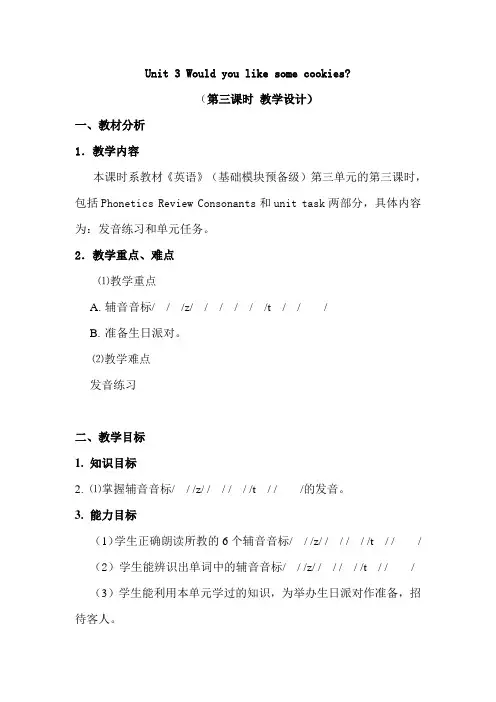
Unit 3 Would you like some cookies?(第三课时教学设计)一、教材分析1.教学内容本课时系教材《英语》(基础模块预备级)第三单元的第三课时,包括Phonetics Review Consonants和unit task两部分,具体内容为:发音练习和单元任务。
2.教学重点、难点⑴教学重点A.辅音音标// /z/ // // /t/ //B.准备生日派对。
⑵教学难点发音练习二、教学目标1.知识目标2.⑴掌握辅音音标// /z/ // // /t/ //的发音。
3.能力目标(1)学生正确朗读所教的6个辅音音标// /z/ // // /t/ // (2)学生能辨识出单词中的辅音音标// /z/ // // /t/ // (3)学生能利用本单元学过的知识,为举办生日派对作准备,招待客人。
4.情感目标学生为举办生日派对作准备,招待客人,增强同学之间的情谊与合作意识。
三、教学步骤Step One Lead-in1. The students listen to a tongue twister: Sixty-six seasick sea serpents swam the six seas. After listening, they tell the teacher what sound is repeated many times in this rhyme.(设计意图:通过听有趣,有节奏的绕口令,引起学生学生音标的兴趣。
并且引出本课中的第一个音标/。
)Step Two Phonetics Review--Consonants1. Activity 26: The students listen to the sentences and tick the words they hear.(设计意图:通过辨认读音,使学生意识到发音的细微差别从而意识到发音准确的重要性。
)2. The students work in pairs. One student reads the words with similar sound. The other guess which word his partner reads.3. Activity 27: The students listen and match the phonetic symbols with proper words.4. The students brainstorm more words with the sounds // /z/ // // /t/ //.(设计意图:通过回忆学过的单词,进一步培养学生辨识相似发音的能力。


基础模块导学案◆Unit 3 A Letter to a Friend Period 1 Useful Words and Expressions 【学习目标】1.掌握重点词汇、短语及其用法。
2.掌握重点句子,分析掌握其结构。
3.加强小组团队合作意识,互助研讨,共同掌握知识点和练习。
课前预习【自学指导】掌握实用词汇。
课前独立完成---必做题(20分)1.关心_______________2.信函_______________3.理解_______________4.说话,讲话_______________5.跟随,领会_______________6.精神紧张,不安的___________7.有好的,友谊的_______________8.有时_______________9.美丽的_______________10.观光_______________【合作探究】掌握短语搭配。
合作发现最基本、最原始的词形和短语结构。
小组成员独立思考并填写下列短语填空,组内讨论确定最佳答案。
(20分)1.很高兴做某事_______________2.中国烹饪_______________3.到达_______________4.在课堂上_______________5.起先,起初_______________6.对……关心_______________7.对某人友好善良的___________8.借助于、利用_______________9.进展顺利_______________10.在上午_______________探究新知(合作互助探究、重点难点突破)【展示点拨】分值:根据实际表现(流畅度、清晰度)赋分:1—5分。
I、词汇解读 讲练结合●1. ago:…ago;一段时间之前。
[课文原文] A month ago, I came to Beijing.[模仿造句]一小时前,我就到学校了。
______________________________________ [实用短语]三天前:_____________; 两周前______________; 一年前_____________ long ago/a long time ago ___________; not long ago ___________; how long ago? ____________ as long ago as…____________________ ; a little while ago ____________________[翻译例句](1)How long ago did it happen? __________________________(2)We spoke on the phone two days ago. __________________________(3)They sold the house a long time ago. __________________________(4)It wasn’t long ago that I saw her. __________________________●2. get to:到达;when:“当(在)…时候”,引导时间状语从句。

Unit 3 Would you like some cookies?(第一课时教学设计)一、学情分析职业学校的学生虽然大多数基础较差,英语表达能力欠缺,但他们有较强的表现欲望,好奇心强,有一定的求知卻,喜欢动手操作。
因此,教师在教学过程中应充分利用学生的特点开展相应活动,如借助图片,PPT,卡片,录音机等教学辅助手段,运用小组讨论,头脑风暴,对话表演,准备生日聚会等方式,让学生在语境中学习语言。
本单元设计分为3个课时:本单元设计分为3个课时:第一课时 lead-in + listening and speaking第二课时 Phonetics review Vowels第三课时Phonetics review Consonants+unit task第一课时 Lead-in + Listening & Speaking二、教材分析1.教学内容本课时系教材《英语》(基础模块预备级)第三单元的第一课时,包括Lead-in & Listening and speaking两部分,具体内容为:询问对方意愿,表达自己的意愿,听懂并掌握询问和表达意愿的词汇、句型。
2.教学重点、难点⑴教学重点询问对方意愿,表达自己的意愿,听懂并掌握询问和表达意愿的词汇、句型⑵教学难点食物,饮料类名词;询问对方意愿,表达自己的意愿的词汇、句型三、教学目标1.知识目标⑴掌握食物,饮料,物品类词汇,如doll; candle; balloon; bottle;cola; popcorn; wine; beer; cookie;⑵询问和表达意愿的句型,如:Would you like…?I’d like….How about…?2.能力目标⑴学生能听懂关于询问和提供个人信息的对话。
⑵学生能编写关于询问和提供个人信息的对话。
(3)在日常生活中灵活应用招待客人的英语表达方式.3.情感目标学生了解在不同的场合,招待不同对象所使用的表达方式。

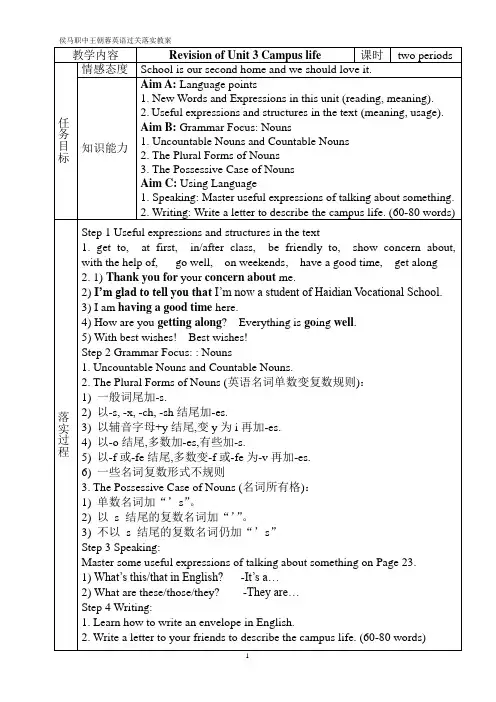
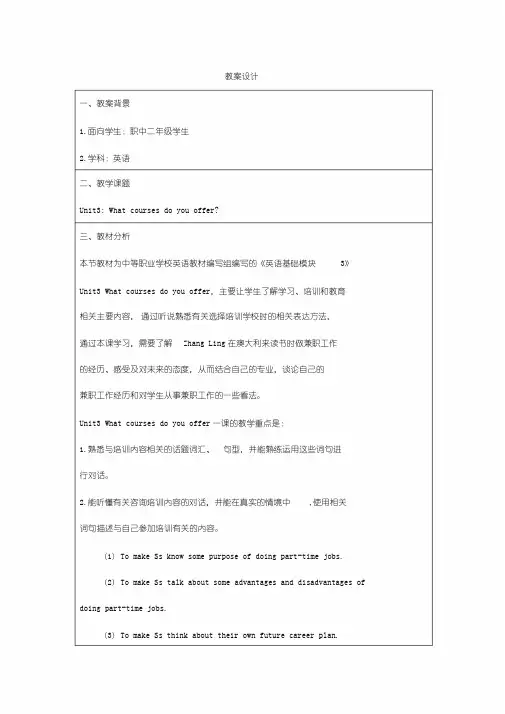
教案设计一、教案背景1.面向学生:职中二年级学生2.学科:英语二、教学课题Unit3: What courses do you offer?三、教材分析本节教材为中等职业学校英语教材编写组编写的《英语基础模块3》Unit3 What courses do you offer,主要让学生了解学习、培训和教育相关主要内容,通过听说熟悉有关选择培训学校时的相关表达方法,通过本课学习,需要了解Zhang Ling在澳大利来读书时做兼职工作的经历、感受及对未来的态度,从而结合自己的专业,谈论自己的兼职工作经历和对学生从事兼职工作的一些看法。
Unit3 What courses do you offer一课的教学重点是:1.熟悉与培训内容相关的话题词汇、句型,并能熟练运用这些词句进行对话。
2.能听懂有关咨询培训内容的对话,并能在真实的情境中,使用相关词句描述与自己参加培训有关的内容。
(1) To make Ss know some purpose of doing part-time jobs.(2) To make Ss talk about some advantages and disadvantages of doing part-time jobs.(3) To make Ss think about their own future career plan.教学难点是:1.能识别“what”引导的主语从句和“It is ...”的主语从句结构。
能区分“what”引导的主语从句和“what”引导的感叹句。
四、教学目标1.词汇目标(1)学生能识别offer, course, schedule, lecture, certificate, homepage, register的意思。
(2)学生能用get a certificate, offer a course, register on line等重要词组来描述参加培训的相关内容。
Unit 3 Campus lifePeriod I A letter to a FriendVocabulary 学习目标:通过复习,掌握本单元的单词和短语。
一.预习检测。
I. Learn the text-skin the passageAnswer the following questions according to the text.(1)Where is David now? (2)Why did he come to Chins?(3)Who are very concern about his life and study?(4)How many classes did he have a day? (5)Who help David?(6)How many classes are there in his school?(7)What did he do on weekends? (8)How did Jennifer get in touch with David?(9)Is David having a good time or not?二.自主探究Ⅰ.英汉互译。
1.到达 _____________2.at first ___________3.对某人来说是谋生的_________________4.in the morning _______________5.对某人友好________________6.have a good time ________________7.对……关心 __________________ 8.a month ago_____________ 9.在……的帮助下___________________ 10.on weekends _________________Ⅱ.词汇。
三.知识点:1.A month ago, I came to Beijing.一个月前我来到北京。
Unit3 Campus life第1课时 Words主备人: 审核人:同年级英语教师执教人: 使用时间:教师寄语:In doing we learn.边干边学。
学习目标:1.学习并识记新单词.2.能灵活运用单词及短语。
学习重点:学习并掌握新单词学习难点:灵活运用单词及短语学习过程:Step 1 【快乐自学】1.打开课本P91, 听录音自学新单词.2.请根据音标大声读出下列单词并写出下列单词以及他们的中文意思。
(手写比较简单的音标让学生读)[ˈletə] _______ _______ [mʌnθ]_______ _______[ˌʌndəˈstænd]_______ _______ [ˈnɜ:vəs]_______ _______[ˈnʌmbə(r)] _______ _______ [ˈju:ʒuəli]_______ _______[əˈdres] _______ _______ [ˈfrendli] _______ _______ [ˌwi:kˈend]_______ _______ [ˈtelɪfəʊn]_______ _______3。
教师领读学生不会读的单词.4.小组长再次领读其余学生不会读的单词.Step 2 【合作共赢】 ( 小组合作学习并展示):1.小组长检测单词记忆情况,并相互提问。
2.词组互译将下列词组或短语译成中文或英文.1.对。
.。
.表示关心 _____________________2.手机短信 ______________________3. 在.。
.。
.的帮助下 _________________________4。
进展顺利 ________________________5.去观光___________________6。
on weekends _________________________7. in class_______________________8。
中职英语公开课教案模板Unit3CampusLifeTheFirstPeriodWarmingupandReadingPanjiquVocationalEduc ationCenterJiangQingzhenI.TeachingAimsandDemands1.KnowledgeObjects1)KeyWordsLettertelllearnagowhengetspeakunderstandfollowfeelnervousfriendlyshowhelpwellusuallysometimesoftennumbersend2)UsefulExpreionsinclagettoatfirstshowconcernaboutwiththehelpofgowellhaveagoodtime3)TargetLanguage(1)Thankyouforyourconcernaboutme.(2)Luckily,alltheteachersandstudentshereareverykindandfriendlytome.(3 )Intheafternoon,wesometimesgototheskilltrainingcenterofourschooltopra cticecookingskills.(4)I’mgladtosaythatwiththehelpoftheteachersand myc lamates.(5)Everythingisgoingwell.2.AbilityObjectsTrainthestudents’listeni;ng,speaking,readingandwritingskills3.MoralO bjectLetthestudentslovetheircampuslife.II.TeachingKeyandDifficultPoints1.S tudentscanintroducecampuslife.2.Payattentiontotheformofaletter.3.Stud entscanmasterkeywordsandphrases.III.TeachingMethods1.Practicemethood.2.Four-skillmethod.IV.Learningstrategies1.Practice2.Roleplay.3.cooperation.V .TeachingAids1.Somepictures3.Asmallblackboard2.AtaperecordingVI.Teach ingProcedureStep1Warmingupandreview1.GreetingeachotherT:Clabegins. Ss:Goodmorning,teacher!T:Goodmorning,cla!Sitdown,please.Ss:Thankyou.2.LookatthepicturesofournewschoolT:Today,I’mveryglad.Ihavesomebeauti fulpicturesofournewschooltoshowyou,Pleaselookatthesepictures.Thisisou rnewschool.Thatisaclaroom,it’sbigandbright.Thisisalibrary,Thatisadin inghall.Thisisadormitoryandthatisaplayground.Pleasereadthewords“scho ol,claroom,library,playground,dininghallanddormitory”afterme.(Inthispart,letthestudentsmasterschoolbuildingsandequipmentteatativel y.)3.Askandanswer(1)T:Lookatthepictures,askandanswerinpairswiththefol lowingsentencesructures:A:What’sthis\\\\thatinEnglish?B:It’sa_______.A:What’sinit?B:Therearesome/many/alotof___________init.T:I’llgiveyouafewminutesto praciceinpairs.(2)Askafewpairstopracticedialogesinpairs.(Inthispart,trainthestudentsspokenEnglishandletthemgoovertheknowledge ofUnit1andUnit2.)Step2Presentation1.Leadinthestudents’campuslifeT:Justnowwesawsomeschoolbuildingsandeq uipment,butIdon’tknoww hatyourcampuslifeis.Canyoutellmeaboutit?Ss:Yes ,wecan.T:Howmanyclaesdoyouhaveinthemorning?Ss:Fourclaes.T:Howmanyclaesdoyouhaveintheafternoon?Ss:Threeclaes.T:Doyouhaveanyinterestingactivitiesaftercla?Ss:Yes,wedo.(Inthispart,showthestu dents’realcampuslifeatfirsttoprepareforthenext step.)2.LearnthenewwordsandleadtothetextAlettertoaFriend.(1)T:FromthetextIknowDavid’scampuslifeisrichandinteresting.Inorderto understandthetextwell,let’slearnthenewwordsinPage137-138.Askseveralstudentstoreadthenewwordstochecktheirpreviewing.(2)Askafewstudentstoreadthekeywordsandphrasesontheblackboardtoconsoli datekeyvocabularyinthetextagain.KeyWords:lettertelllearnagowhengetspe akunderstandfollowfeednervousfriendlyshowhelpwellusuallysometimesofte nnumbersendUsefulExpreions:incla,gettoatfirst,showconcernabout,gowell,withthehelpof,haveagoodtim e(Inthepart,letthestudentsmasterkeywordsandusefulexpreionsinthetextbef orelistiningandreadinginordertoremovereadingobstructions.)Step3Consol idation1.ShowthefollowingquestionsaboutthetextonthesmallBb:(1)WhatdoesDaviddoinHaidianVocationalSchoolinBeijing?(2)WhatdoesDavid thinkofalltheteachersandstudentsthere?(3)HowmanyclaesdoesDavidhaveada ytromMondaytoFriday?(4)WhatdoesDavidoftendoonweekends?2.Playtherecordingandaskthestudendstolistentothetapeandfindtheanswers,butsomestudentscanlookatthetextastheylisten.3.Askfourstudentstocheck theanswers.(1)HeliarnsChinesecookinginHaidianVocationalSchoolinBeijing.(2)Theyar ekindandfriendly.(3)Hehassevenclaesaday.(4)Heoftengoestohaveclaesofth eChineselanguageorgosightseeingaroundthegreatandbeautifulcityofBeijin g.(Inthepart,letthestudentsgettoknowthetextstepbystep.)Step4Practice1.Askthestudentstoreadthetextagainandtocompletethefollowingstatements accordingtothetextPage20.2.Checktheanswers.3.Playtherecrdingagainandaskthestudentstoreadafterit.T:Pleasereadafterthetapeandpayattentiontopronunciation,intonationands tre.4.Theteacherexplainsknowledgethatthestudentsdon’tknow.5.Askthest udentstonoticetheformoftheletter.Step5Extending1.Piontouttheinstructi onstothestudents.T:Everystudenthasgoodfriends,buttheydon’tknowhowyou rcampuslifeisgoing.Canyouwritealettertotellhim/heraboutit?Ss:Yes,Ican.T:Whenyouwritealettertoyourfriendyoushouldpayattentiontotheformofalett er.I’llgiveyousomeminutestowrite.2.Whenthestudentswriteletterstheteacherwalksaroundtheclaroomandhelpst udentswhoneedsomehelp.3.Askafewstudentstoshowtheirlettersthatarewritt enbythemselvestotheotherstudents.Step6SummaryTheteacherandstudentssumupknowledgethatislearntinthisleontogether.Ste p7Homework1.Gooverthewordsandexpreionsinthisleon.2.Readthetexttentimes.3.Dothee xercisesonPage21.Step8BlackboardDesignUnit3CampusLifeTheFirstPeriodWarmingupandReadingSentenceStructures: A:What’sthis\\\\thatinEnglish?B:It’sa____.A:What’sinit?B:Therearesome\\\\mary\\\\alotof____init.KeyWords:LettertelllearnagowhengetspeakunderstandfollowfeelnervousfriendlyshowhelpwellusuallysometimesoftennumbersendUsefulExpreions:inclagettoatfirstgowellshowconcernabouthaveagoodtimewiththehelpofbefriendlytosb.KeySentenceStructures:1.I’mgladto…2.Atfirst,….3.Wehave…claesinthemorning.4.Howareyougettingalone?KeySentences:1.Thankyouforyourconcernaboutme.2.Luckily,alltheteachersandStudentshereareverykindandfriendlytome.3.I ntheafternoon,wesometimesgototheskilltrainingcenterofourschooltopract icecookingskills.4.I’mgladtosaythatwiththehelpoftheteachersandmyclamates,everythingis goingwell.Step9TeachingReflectionInthisleon,Itookadministrative-levelteachingsA,B,Caccordingtothestudents’differentfoundations.Iaske dthestudentsofpoorfoundationtodoeasyexercisesandthestudentsofgoodfoun dationtodifficultexercisesandtheotherstodomiddledifficultexercises.Th at’sthecase,theycoulddowellandfeltsucceful,sotheymaybeinterestedinEnglish.Inthefuture,IamgoingtotrainsomestudentswhoareweakatEnglishafter cla.Ihopethatallthestudentsinpreschooleducationcla3canmakeprogreinthi sschoolyear\\\\academicyear.中职数学公开课教案【篇1:中职数学(基础模块)上册教案】中职数学(基础模块)教案1.1集合的概念知识目标:(1)理解集合、元素及其关系;(2)掌握集合的列举法与描述法,会用适当的方法表示集合.能力目标:通过集合语言的学习与运用,培养学生的数学思维能力.教学重点:集合的表示法.教学难点:集合表示法的选择与规范书写.课时安排:2课时.1.2集合之间的关系知识目标:(1)掌握子集、真子集的概念;(2)掌握两个集合相等的概念;(3)会判断集合之间的关系.能力目标:通过集合语言的学习与运用,培养学生的数学思维能力.教学重点:集合与集合间的关系及其相关符号表示.教学难点:真子集的概念.课时安排:2课时.1.3集合的运算(1)知识目标:(1)理解并集与交集的概念;(2)会求出两个集合的并集与交集.能力目标:(1)通过数形结合的方法处理问题,培养学生的观察能力;(2)通过交集与并集问题的研究,培养学生的数学思维能力.教学重点:交集与并集.教学难点:用描述法表示集合的交集与并集.课时安排:2课时.1.3集合的运算(2)知识目标:(1)理解全集与补集的概念;(2)会求集合的补集.能力目标:(1)通过数形结合的方法处理问题,培养学生的观察能力;(2)通过全集与补集问题的研究,培养学生的数学思维能力.教学重点:集合的补运算.教学难点:集合并、交、补的综合运算.课时安排:2课时.1.4充要条件知识目标:了解“充分条件”、“必要条件”及“充要条件”.能力目标:通过对条件与结论的研究与判断,培养思维能力.教学重点:(1)对“充分条件”、“必要条件”及“充要条件”的理解.(2)符号“”,“”,“”的正确使用.教学难点:“充分条件”、“必要条件”、“充要条件”的判定.课时安排:2课时.2.1不等式的基本性质知识目标:⑴理解不等式的基本性质;⑵了解不等式基本性质的应用.能力目标:⑴了解比较两个实数大小的方法;⑵培养学生的数学思维能力和计算技能.教学重点:⑴比较两个实数大小的方法;⑵不等式的基本性质.教学难点:比较两个实数大小的方法.课时安排:1课时.2.2区间知识目标:⑴掌握区间的概念;⑵用区间表示相关的集合.能力目标:通过数形结合的学习过程,培养学生的观察能力和数学思维能力.教学重点:区间的概念.教学难点:区间端点的取舍.课时安排:1课时.2.3一元二次不等式知识目标:⑴了解方程、不等式、函数的图像之间的联系;⑵掌握一元二次不等式的图像解法.能力目标:⑴通过对方程、不等式、函数的图像之间的联系的研究,培养学生的观察能力与数学思维能力;⑵通过求解一元二次不等式,培养学生的计算技能.教学重点:⑴方程、不等式、函数的图像之间的联系;⑵一元二次不等式的解法.教学难点:一元二次不等式的解法.课时安排:2课时.2.4含绝对值的不等式知识目标:(1)理解含绝对值不等式或的解法;(2)了解或的解法.能力目标:(1)通过含绝对值不等式的学习;培养学生的计算技能与数学思维能力;(2)通过数形结合的研究问题,培养学生的观察能力.教学重点:(1)不等式或的解法.(2)利用变量替换解不等式或.教学难点:利用变量替换解不等式或.课时安排:2课时.3.1函数的概念及其表示法知识目标:(1)理解函数的定义;(2)理解函数值的概念及表示;(3)理解函数的三种表示方法;(4)掌握利用“描点法”作函数图像的方法.能力目标:(1)通过函数概念的学习,培养学生的数学思维能力;(2)通过函数值的学习,培养学生的计算能力和计算工具使用技能;(3)会利用“描点法”作简单函数的图像,培养学生的观察能力和数学思维能力.教学重点:(1)函数的概念;(2)利用“描点法”描绘函数图像.教学难点:(1)对函数的概念及记号的理解;(2)利用“描点法”描绘函数图像.课时安排:2课时.3.2函数的性质知识目标:⑴理解函数的单调性与奇偶性的概念;⑵会借助于函数图像讨论函数的单调性;⑶理解具有奇偶性的函数的图像特征,会判断简单函数的奇偶性.能力目标:⑴通过利用函数图像研究函数性质,培养学生的观察能力;⑵通过函数奇偶性的判断,培养学生的数学思维能力.教学重点:⑴函数单调性与奇偶性的概念及其图像特征;⑵简单函数奇偶性的判定.教学难点:函数奇偶性的判断.(*函数单调性的判断)课时安排:2课时. 3.3函数的实际应用举例知识目标:(1)理解分段函数的概念;(2)理解分段函数的图像;(3)了解实际问题中的分段函数问题.能力目标:(1)会求分段函数的定义域和分段函数在点处的函数值;(2)掌握分段函数的作图方法;(3)能建立简单实际问题的分段函数的关系式.教学重点:(1)分段函数的概念;(2)分段函数的图像.教学难点:(1)建立实际问题的分段函数关系;(2)分段函数的图像.课时安排:2课时.4.1实数指数幂(1)知识目标:⑴复习整数指数幂的知识;⑵了解n次根式的概念;⑶理解分数指数幂的定义.能力目标:⑴掌握根式与分数指数幂之间的转化;⑵会利用计算器求根式和分数指数幂的值;⑶培养计算工具使用技能.教学重点:分数指数幂的定义.教学难点:根式和分数指数幂的互化.课时安排:2课时.4.1实数指数幂(2)知识目标:⑴掌握实数指数幂的运算法则;⑵通过几个常见的幂函数,了解幂函数的图像特点.能力目标:⑴正确进行实数指数幂的运算;⑵培养学生的计算技能;⑶通过对幂函数图形的作图与观察,培养学生的计算工具使用能力与观察能力. 教学重点:有理数指数幂的运算.教学难点:有理数指数幂的运算.课时安排:2课时.4.2指数函数知识目标:⑴理解指数函数的图像及性质;⑵了解指数模型,了解指数函数的应用.能力目标:⑴会画出指数函数的简图;⑵会判断指数函数的单调性;⑶了解指数函数在生活生产中的部分应用,从而培养学生分析与解决问题能力.教学重点:⑴指数函数的概念、图像和性质;⑵指数函数的应用实例.教学难点:指数函数的应用实例.课时安排:2课时.4.3对数知识目标:⑴理解对数的概念,理解常用对数和自然对数的概念;⑵掌握利用计算器求对数值的方法;⑶了解积、商、幂的对数.能力目标:⑴会进行指数式与对数式之间的互化;⑵会运用函数型计算器计算对数值;⑶培养计算工具的使用技能.教学重点:指数式与对数式的关系.教学难点:对数的概念.课时安排:2课时.4.4对数函数知识目标:⑴了解对数函数的图像及性质特征;⑵了解对数函数的实际应用.能力目标:⑴观察对数函数的图像,总结对数函数的性质,培养观察能力;⑵通过应用实例的介绍,培养学生数学思维能力和分析与解决问题能力.教学重点:对数函数的图像及性质.教学难点:对数函数的应用中实际问题的题意分析.课时安排:2课时.5.1角的概念推广知识目标:⑴了解角的概念推广的实际背景意义;⑵理解任意角、象限角、界限角、终边相同的角的概念.能力目标:(1)会判断角所在的象限;(2)会求指定范围内与已知角终边相同的角;(3)培养观察能力和计算技能.教学重点:终边相同角的概念.教学难点:终边相同角的表示和确定.课时安排:2课时.5.2弧度制知识目标:⑴理解弧度制的概念;⑵理解角度制与弧度制的换算关系.能力目标:(1)会进行角度制与弧度制的换算;(2)会利用计算器进行角度制与弧度制的换算;(3)培养学生的计算技能与计算工具使用技能.教学重点:弧度制的概念,弧度与角度的换算.教学难点:弧度制的概念.课时安排:2课时.5.3任意角的正弦函数、余弦函数和正切函数知识目标:⑴理解任意角的三角函数的定义及定义域;⑵理解三角函数在各象限的正负号;⑶掌握界限角的三角函数值.能力目标:⑴会利用定义求任意角的三角函数值;⑵会判断任意角三角函数的正负号;⑶培养学生的观察能力.教学重点:⑴任意角的三角函数的概念;⑵三角函数在各象限的符号;⑶特殊角的三角函数值.教学难点:任意角的三角函数值符号的确定.课时安排:2课时.5.4同角三角函数的基本关系知识目标:理解同角的三角函数基本关系式.能力目标:⑴已知一个三角函数值,会利用同角三角函数的基本关系式求其他的三角函数值;⑵会利用同角三角函数的基本关系式求三角式的值.教学重点:同角的三角函数基本关系式的应用.教学难点:应用平方关系求正弦或余弦值时,正负号的确定.课时安排:2课时.能力目标:(1)会利用简化公式将任意角的三角函数的转化为锐角的三角函数;(2)会利用计算器求任意角的三角函数值;(3)培养学生的数学思维能力及应用计算工具的能力.教学重点:三个诱导公式.教学难点:诱导公式的应用.课时安排:2课时.5.6三角函数的图像和性质知识目标:(1)理解正弦函数的图像和性质;(2)理解用“五点法”画正弦函数的简图的方法;(3)了解余弦函数的图像和性质.能力目标:(1)认识周期现象,以正弦函数、余弦函数为载体,理解周期函数;(2)会用“五点法”作出正弦函数、余弦函数的简图;(3)通过对照学习研究,使学生体验类比的方法,从而培养数学思维能力.教学重点:(1)正弦函数的图像及性质;(2)用“五点法”作出函数y=sinx在上的简图.教学难点:周期性的理解.课时安排:2课时.5.7已知三角函数值求角知识目标:(1)掌握利用计算器求角度的方法;(2)了解已知三角函数值,求指定范围内的角的方法.能力目标:(1)会利用计算器求角;(2)已知三角函数值会求指定范围内的角;(3)培养使用计算工具的技能.教学重点:已知三角函数值,利用计算器求角;利用诱导公式求出指定范围内的角.教学难点:已知三角函数值,利用计算器求指定范围内的角.【篇2:中职数学(基础模块)教案】中职数学(基础模块)教案1.1集合的概念知识目标:(1)理解集合、元素及其关系;(2)掌握集合的列举法与描述法,会用适当的方法表示集合.能力目标:通过集合语言的学习与运用,培养学生的数学思维能力.教学重点:集合的表示法.教学难点:集合表示法的选择与规范书写.课时安排:2课时.1.2集合之间的关系知识目标:(1)掌握子集、真子集的概念;(2)掌握两个集合相等的概念;(3)会判断集合之间的关系.能力目标:通过集合语言的学习与运用,培养学生的数学思维能力.教学重点:集合与集合间的关系及其相关符号表示.教学难点:真子集的概念.课时安排:2课时.1.3集合的运算(1)知识目标:(1)理解并集与交集的概念;(2)会求出两个集合的并集与交集.能力目标:(1)通过数形结合的方法处理问题,培养学生的观察能力;(2)通过交集与并集问题的研究,培养学生的数学思维能力.教学重点:交集与并集.教学难点:用描述法表示集合的交集与并集.课时安排:2课时.1.3集合的运算(2)知识目标:(1)理解全集与补集的概念;(2)会求集合的补集.能力目标:(1)通过数形结合的方法处理问题,培养学生的观察能力;(2)通过全集与补集问题的研究,培养学生的数学思维能力.教学重点:集合的补运算.教学难点:集合并、交、补的综合运算.课时安排:2课时.1.4充要条件知识目标:了解“充分条件”、“必要条件”及“充要条件”.能力目标:通过对条件与结论的研究与判断,培养思维能力.教学重点:(1)对“充分条件”、“必要条件”及“充要条件”的理解.(2)符号“”,“”,“”的正确使用.教学难zyb重油煤焦油专用泵点:“充分条件”、“必要条件”、“充要条件”的判定.课时安排:2课时.2.1不等式的基本性质知识目标:⑴理解不等式的基本性质;⑵了解不等式基本性质的应用.能力目标:⑴了解比较两个实数大小的方法;⑵培养学生的数学思维能力和计算技能.教学重点:⑴比较两个实数大小的方法;⑵不等式的基本性质.教学难点:比较两个实数大小的方法.课时安排:1课时.2.2区间知识目标:⑴掌握区间的概念;⑵用区间表示相关的集合.能力目标:通过数形结合高温导热油泵的学习过程,培养学生的观察能力和数学思维能力.教学重点:区间的概念.教学难点:区间端点的取舍.课时安排:1课时.2.3一元二次不等式知识目标:⑴了解方程、不等式、函数的图像之间的联系;⑵掌握一元二次不等式的图像解法.能力目标:⑴通过对方程、不等式、函数的图像之间的联系的研究,培养学生的观察能力与数学思维能力;⑵通过求解一元二次不等式,培养学生的计算技能.教学重点:⑴方程、不等式、函数的图像之间的联系;⑵一元二次不等式的解法.教学难点:一元二次不等式的解法.课时安排:2课时.2.4含绝对值的不等式知识目标:(1)理解含绝对值不等式或的解法;(2)了解或的解法.能力目标:(1)通过含绝对值不等式的学习;培风冷式离心油泵养学生的计算技能与数学思维能力;(2)通过数形结合的研究问题,培养学生的观察能力.教学重点:(1)不等式或的解法.(2)利用变量替换解不等式或.教学难点:利用变量替换解不等式或.课时安排:2课时.3.1函数的概念及其表示法知识目标:(1)理解函数的定义;(2)理解函数值的概念及表示;(3)理解函数的三种表示方法;(4)掌握利用“描点法”作函数图像的方法.能力目标:(1)通过函数概念的学习,培养学生的数学思维能力;(2)通过函数值的学习,培养学生的计算能力和计算工具使用技能;(3)会利用“描点法”作简单函数的图像,培养学生的观察能力和数学思维能力.教学重点:(1)函数的概念;(2)利用“描点法”描绘函数图像.教学难点:(1)对函数的概念及记号的理解;(2)利用“描点法”描绘函数图像.课时安排:2课时.3.2函数的性质知识目标:⑴理解函数的单bwcb沥青泵调性与奇偶性的概念;⑵会借助于函数图像讨论函数的单调性;⑶理解具有奇偶性的函数的图像特征,会判断简单函数的奇偶性.能力目标:⑴通过利用函数图像研究函数性质,培养学生的观察能力;⑵通过函数奇偶性的判断,培养学生的数学思维能力.教学重点:⑴函数单调性与奇偶性的概念及其图像特征;⑵简单函数奇偶性的判定.教学难点:函数奇偶性的判断.(*函数单调性的判断)课时安排:2课时.3.3函数的实际应用举例知识目标:(1)理解分段函数的概念;(2)理解分段函数的图像;(3)了解实际问题中的分段函数问题.能力目标:(1)会求分段函数的定义域和分yhb立式齿轮泵段函数在点处的函数值;(2)掌握分段函数的作图方法;(3)能建立简单实际问题的分段函数的关系式.教学重点:(1)分段函数的概念;(2)分段函数的图像.教学难点:(1)建立实际问题的分段函数关系;(2)分段函数的图像.课时安排:2课时.4.1实数指数幂(1)知识目标:⑴复习整数指数幂的知识;⑵了解n次根式的概念;⑶理解分数指数幂的定义.能力目标:⑴掌握根式与分数指数幂之间的转化;⑵会利用计算器求根式和分数指数幂的值;⑶培养计算工具使用技能.教学重点:分数指数幂的定义.教学难点:根式和分数yhb轴头齿轮油泵指数幂的互化.课时安排:2课时.4.1实数指数幂(2)知识目标:⑴掌握实数指数幂的运算法则;⑵通过几个常见的幂函数,了解幂函数的图像特点.能力目标:⑴正确进行实数指数幂的运算;⑵培养学生的计算技能;⑶通过对幂函数图形的作图与观察,培养学生的计算工具使用能力与观察能力.教学重点:有理数指数幂的运算.教学难点:有理数指数幂的运算.课时安排:2课时.4.2指数函数知识目标:⑴理解指数函数的图像及性质;⑵了解指数模型,了解指数函数的应用.能力目标:⑴会画出指数函数的简图;⑵会判断指数函数的单调性;⑶了解指数函数在生活生产中的部分应用,从而培养学生分析与解决问题能力.教学重点:⑴指数函数的概念、图像和性质;⑵指数沥青拌合站增压泵函数的应用实例.教学难点:指数函数的应用实例.课时安排:2课时.4.3对数知识目标:⑴理解对数的概念,理解常用对数和自然对数的概念;⑵掌握利用计算器求对数值的方法;⑶了解积、商、幂的对数.能力目标:⑴会进行指数式与对数式之间的互化;⑵会运用函数型计算器计算对数值;⑶培养计算工具的使用技能.教学重点:指数式与对数式的关系.教学难点:对数的ycb齿轮泵概念.课时安排:2课时.4.4对数函数知识目标:⑴了解对数函数的图像及性质特征;⑵了解对数函数的实际应用.能力目标:⑴观察对数函数的图像,总结对数函数的性质,培养观察能力;⑵通过应用实例的介绍,培养学生数学思维能力和分析与解决问题能力.教学重点:对数函数的图像及性质.教学难点:对数函数的应用中实际zyb-33.3a问题的题意分析.课时安排:2课时.5.1角的概念推广知识目标:⑴了解角的概念推广的实际背景意义;⑵理解任意角、象限角、界限角、终边相同的角的概念.能力目标:(1)会判断角所在的象限;(2)会求指定范围内与已知角终边相同的角;(3)培养观察能力和计算技能.教学重点:终边相同角的概念.教学难点:终边相同角的表示和确定.课时安排:2课时.5.2弧度制知识目标:⑴理解弧度制的概念;⑵理解角度制与弧度制的换算关系.能力目标:(1)会进行角度制与弧度制的换算;(2)会利用计算器进行角度制与弧度制的换算;(3)培养学生的计算技能与计算工具使用技能.教学重点:弧度制的概念,弧度与角度的换算.教学难点:弧度制的概念.课时安排:2课时.5.3任意角的正弦函数、余弦函数和正切函数知识目标:⑴理解任意角的三角函数的定义及定义域;⑵理解三角函数在各象限的正负号;⑶掌握界限角的三zyb系列渣油泵角函数值.能力目标:⑴会利用定义求任意角的三角函数值;⑵会判断任意角三角函数的正负号;⑶培养学生的观察能力.教学重点:⑴任意角的三角函数的概念;⑵三角函数在各象限的符号;⑶特殊角的三角函数值.教学难点:任意角的三角函数值符号的确定.课时安排:2课时.5.4同角三角函数的基本关系知识目标:理解同角的三角函数基本关系式.能力目标:⑴已知一个三角函数值,会利用同角三角函数的基本关系式求其他的三角函数值;⑵会利用同角三角函数的基本关系式求三角式的值.教学重点:同角的三角函数基本关系式的应用.教学难点:应用平方关系求正弦或余弦值时,正负号的确定.课时安排:2课时.5.5诱导公式能力目标:(1)会利用简化公式搅拌站渣油泵将任意角的三角函数的转化为锐角的三角函数;(2)会利用计算器求任意角的三角函数值;(3)培养学生的数学思维能力及应用计算工具的能力.教学重点:三个诱导公式.教学难点:诱导公式的应用.课时安排:2课时.5.6三角函数的图像和性质知识目标:(1)理解正弦函数的图像和性质;(2)理解用“五点法”画正弦函数的简图的方法;(3)了解余弦函数的图像和性质.能力目标:(1)认识周期现象,以正弦zyb型增压渣油泵函数、余弦函数为载体,理解周期函数;(2)会用“五点法”作出正弦函数、余弦函数的简图;(3)通过对照学习研究,使学生体验类比的方法,从而培养数学思维能力.教学重点:(1)正弦函数的图像及性质;(2)用“五点法”作出函数y=sinx在上的简图.教学难点:周期性的理解.课时安排:2课时.5.7已知三角函数值求角知识目标:(1)掌握利用计算器求角度的方法;(2)了解已知三角函数值,求指定范围内的角的方法.能力目标:(1)会利用计算器求角;(2)已知三角函数值会求指定范围内的角;(3)培养使用计算工具的技能.教学重点:已知三角函数值,利用计算器求角;利用诱导公式求出指定范围内的角.教学难点:已知三角函数值,利用计算器求指定范围内的角.课时安排:2课时.6.1数列的概念知识目标:(1)了解数列的有关zyb重油泵概念;(2)掌握数列的通项(一般项)和通项公式.能力目标:通过实例引出数列的定义,培养学生的观察能力和归纳能力.教学重点:利用数列的通项公式写出数列中的任意一项并且能判断一个数是否为数列中的一项.教学难点:根据数列的前若干项写出它的一个通项公式.课时安排:2课时.6.2等差数列(一)知识目标:(1)理解等差数列的定义;(2)理解等差数列通项公式.能力目标:通过学习等差数列的通项公式,培养学生处理数据的能力.教学重点:等差数列的通项公式.教学难点:等差数列通项公式的推导.课时安排:2课时.6.2等差数列知识目标:理解等差数列通项公式及前项和公式.能力目标:通过学习前项和公zyb煤焦油泵式,培养学生处理数据的能力.教学重点:等差数列的前项和的公式.教学难点:等差数列前项和公式的推导.课时安排:2课时.6.3等比数列【篇3:中职数学基础模块上册教案】人教版中职数学教材基础模块上册全册教案【课题】1.1集合的概念【教学目标】知识目标:(1)理解集合、元素及其关系;(2)掌握集合的列举法与描述法,会用适当的方法表示集合.能力目标:通过集合语言的学习与运用,培养学生的数学思维能力.【教学重点】集合的表示法.【教学难点】集合表示法的选择与规范书写.【教学设计】(1)通过生活中的实例导入集合与元素的概念;(2)引导学生自然地认识集合与元素的关系;(3)针对集合不同情况,认识到可以用列举和描述两种方法表示集合,然后再对表示法进行对比分析,完成知识的升华;(4)通过练习,巩固知识.(5)依照学生的认知规律,顺应学生的学习思路展开,自然地层层推进教学.【教学备品】教学课件.【课时安排】2课时.(90分钟)【教学过程】中职英语教案模板【篇1:中职说课稿模板】【说教材】根据以就业为导向,以能力为本位的中职教育培养目标,我将…..作为本节课的重点与难点,同时根据教学大纲的要求和岗位职业能力的需求,我确定教学目标如下:。